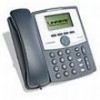Linksys SPA922 Cisco Small Business IP Phone SPA9X1 Administration Guide - Page 15
SPA92x, SPA962, Ensuring Voice Quality, Algorithm, Complexity, MOS Score - headset
 |
UPC - 745883570836
View all Linksys SPA922 manuals
Add to My Manuals
Save this manual to your list of manuals |
Page 15 highlights
Linksys IP Phone Features Chapter 1 Introducing Linksys IP Phones SPA92x, SPA94x, SPA962 The SPA921, SPA922, SPA941, SPA942, and SPA962 provide an LCD display and additional features that are not provided with the SPA901, including the following: • Line Status Indicators: Active Line, Name, and Number • Menu-Driven User Interface • Digits Dialed with Number Auto-Completion • Caller ID Name and Number and Outbound Caller ID Blocking • On-Hook Dialing • Redial from Call Logs • Personal Directory with Auto-dial (100 entries) • On Hook Default Audio Configuration (Speakerphone and Headset) • Called Number with Directory Name Matching • Call Number using Name - Directory Matching or via Caller ID • Subsequent Incoming Calls with Calling Name and Number • Name and Identity (Text) Displayed at Start Up • Distinctive Ringing Based on Calling and Called Number Ensuring Voice Quality Voice quality perceived by the subscribers of the IP Telephony service should be indistinguishable from that of the PSTN. Voice quality can be measured with such methods as Perceptual Speech Quality Measurement (PSQM), with a scale of 1-5, in which lower is better; and Mean Opinion Score (MOS), with a scale of 1-5, in which higher is better. Table 1-2 displays speech quality metrics associated with various audio compression algorithms. For information about bandwidth requirements for each supported codec, refer to Table 2-1 on page 2-10. Table 1-2 Speech Quality Metrics Algorithm G.711 G.726 G.729a G.729 G.723.1 Complexity Very low Low Low-medium Medium High MOS Score 4.5 4.1 (32 kbps) 4 4 3.8 Note Linksys IP phones support all the above voice coding algorithms. Linksys IP Phone Administrator Guide 1-4 Firmware Version 5.1















